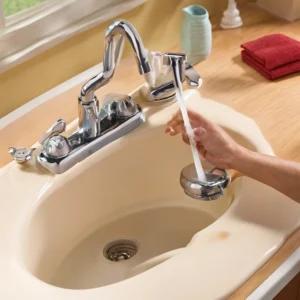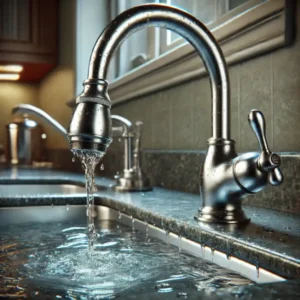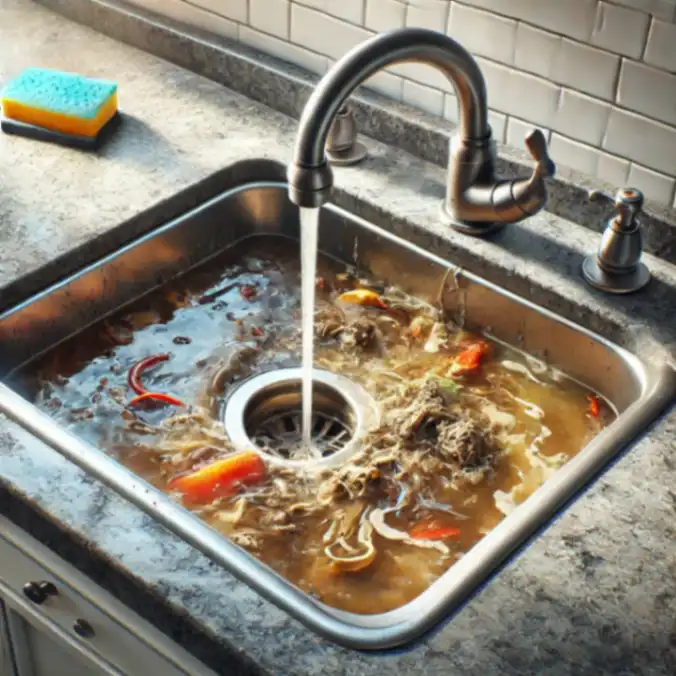[web_stories title=”true” excerpt=”false” author=”true” date=”false” archive_link=”true” archive_link_label=”” circle_size=”150″ sharp_corners=”true” image_alignment=”left” number_of_columns=”1″ number_of_stories=”5″ order=”DESC” orderby=”post_title” view=”carousel” /]Most sink problems happen due to clogs, leaks, and bad smells. Food, hair, and soap sometimes get stuck in the pipes, causing clogs. Leaky faucets are common sink problems that usually happen when parts wear out.
When food particles and grease are stuck in the drain, it causes a bad smell. In this article, we have also defined how to fix these issues if you are facing sink-related trouble. Low water pressure is one of the most common issues nowadays with kitchen and bathroom sinks.
Sink common problems
1. Clogged sinks
A clog in the sink usually happens when food particles, hair, and soap build up in the pipes. Over time, these materials block the flow of water, causing the sink to drain slowly.

How to unclog?
- Boiling water: Pour boiling water down the drain. This may dissolve the blockage if it’s due to grease or soap.
- Use a plunger: Place a plunger over the drain and push down firmly, then pull up quickly. Repeat several times to try and dislodge the clog.
- Baking soda and vinegar: Pour 1/2 cup of baking soda down the drain, followed by 1/2 cup of vinegar. Wait for 15 minutes, then flush with hot water.
- Plumber’s snake: If the clog is stubborn, use a plumber’s snake to reach and remove it. Insert the snake into the drain and turn the handle until we feel resistance, then pull the clog out.
2. Leaky faucets
A leaky faucet usually occurs because the parts inside the faucet, like washers or O-rings, wear out over time. These parts are responsible for sealing off the water when the faucet is turned off. When they wear out, water can leak through.

How to fix it?
- Turn off the water supply: We turn off the water supply to the faucet before repairing it. We usually find the shut-off valves under the sink.
- Disassemble the faucet: We also use a screwdriver to remove the handle of the faucet. This will give us access to the cartridge, washer, or O-ring, which might be causing the leak.
- Inspect and replace parts: We look for worn or damaged parts. The most common culprits are the washer or O-ring. If these are worn out, replace them with new ones. If we faucet uses a cartridge, check it for cracks or wear, and replace it if necessary.
- Reassemble the faucet: Once we’ve replaced the damaged parts, reassemble the faucet by reversing the steps we took to disassemble it.
- Turn on the water supply: After reassembling, turn the water supply back on and test the faucet. If the leak has stopped, we’ve successfully fixed it!
3. Bad smells from the sink
Bad odors from the sink often happen because food particles and grease get stuck in the pipes. These particles start to rot and produce a bad smell.
How to fix it?
- Step 1: Pour baking soda and vinegar down the drain, which is used to clean out the pipes.
- Step 2: Rinse with hot water to wash away any remaining dirt.
- Step 3: To keep sink smelling fresh, clean it regularly and avoid putting food scraps down the drain.
4. Sink Sprayer Problems
Problems with the sink sprayer occur if the hose gets twisted or if mineral deposits build up in the nozzle. This can block the flow of water or make the sprayer less effective.
How to fix it?
- First of all, turn off the water supply to the sink. This prevents water from spraying everywhere when we remove the sprayer.
- Look under the sink for a connection point and carefully unscrew it to disconnect the sprayer hose from the water supply.
- Once the hose is disconnected, we remove the sprayer head.
- Soak the sprayer head in a mixture of warm water and vinegar for about 30 minutes.
- While the sprayer head is soaking, check the hose for any clogs or build-up. Run water through the hose to flush out any debris.
- After cleaning, reattach the sprayer head to the hose.
- Turn the water supply back on and test the sprayer. Check for any leaks at the connection points and ensure that it is working accurately..
5. Problems with composite sinks
Granite or quartz composite sinks develop cracks and stains over time, especially if heavy objects are dropped in them. Fireclay sinks also have similar issues if they are not cared for properly.
How to fix it?
- Step 1: Clean the sink regularly with a non-abrasive cleaner to prevent stains.
- Step 2: If you see small cracks, fill them with a special sink repair kit.
- Step 3: Avoid dropping heavy objects in the sink to prevent damage.
6. Problems with undermount sinks
Undermount sinks sometimes come loose or cause issues with the countertop, especially if it’s made of laminate. This can happen if the sink isn’t installed correctly or if the seal between the sink and countertop wears out.
How to fix it?
- Step 1: Make sure the sink is properly sealed to the countertop.
- Step 2: If the sink comes loose, we may need to reattach it using special clips.
Conclusion:
Sinks have many problems, but with a little know-how, we can fix most of them ourselves. Whether it’s a clogged drain, a leaky faucet, or an issue with the kitchen sink sprayer, these tips help us to keep our sinks working properly. It is also considered in plumbing issues, so you can fix these problems with the basic plumbing tips.

